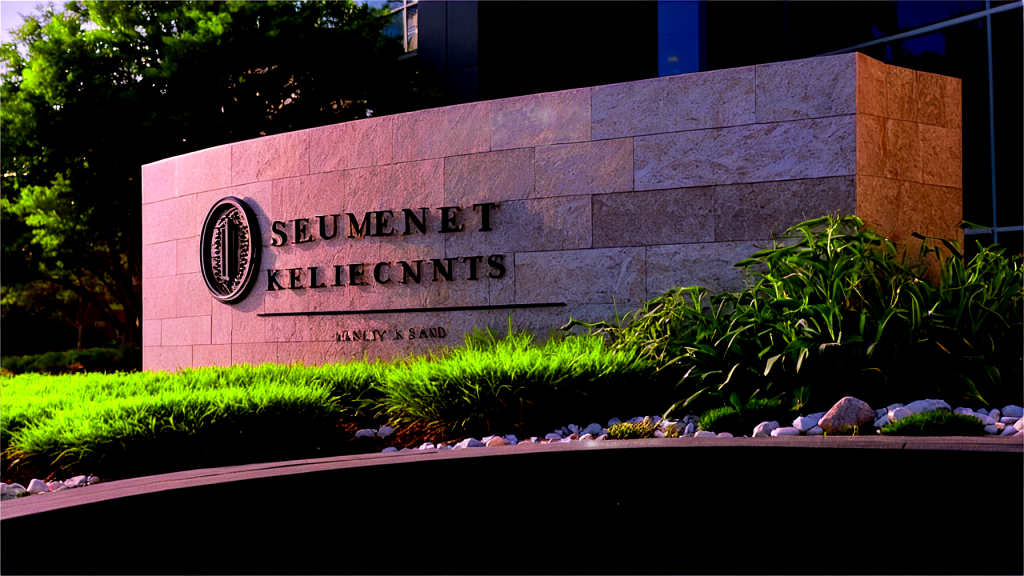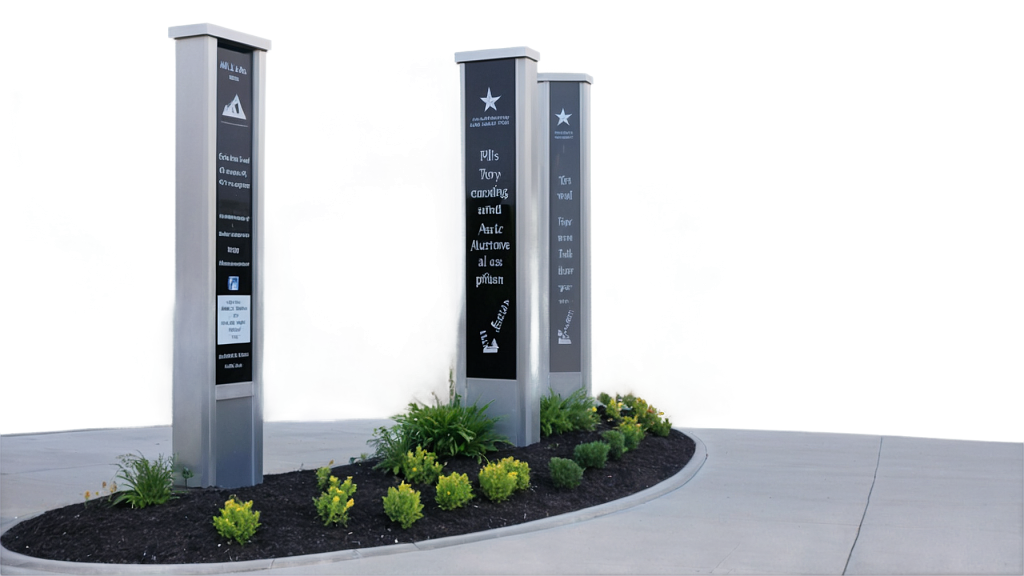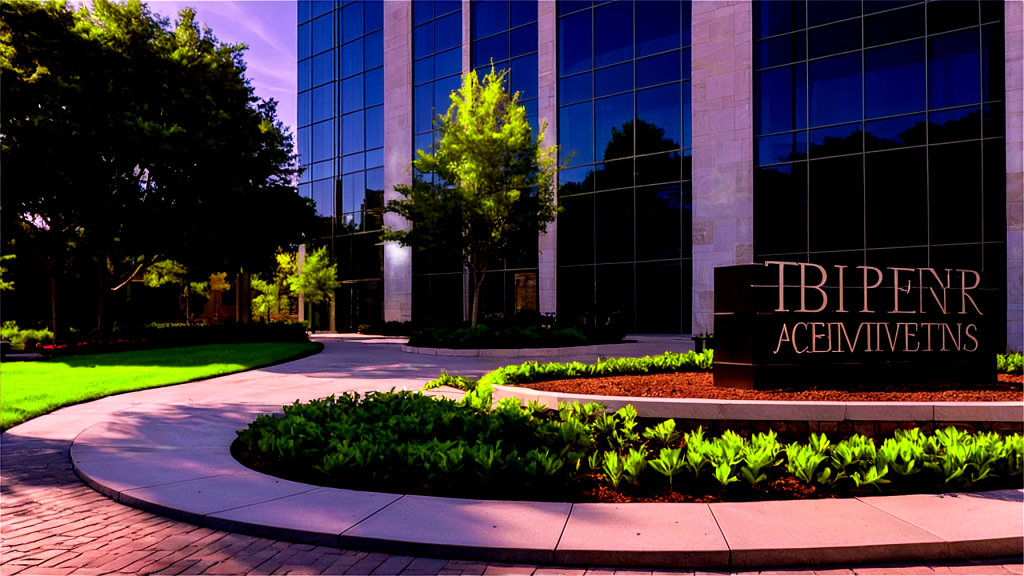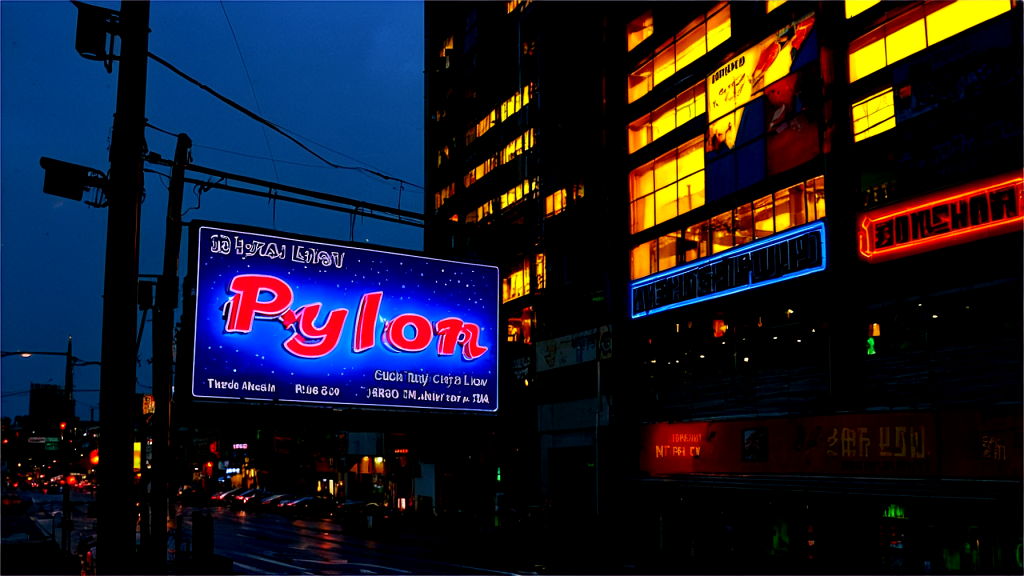Since the popularity and market of outdoor signs are expanding every moment (the Australian sign market hits almost $4 billion), choosing the right one might be staggering. Among all the signs, monument and pylon signs are two, making the choice tough.
When comparing monument vs. pylon signs, the key difference is height and visibility. Monument signs are low-profile and blend with the surrounding environment, while pylon signs rise high, making them visible from a distance.
The right choice depends on factors like traffic patterns, zoning regulations, and your business goals. In this comparison guide, we will explain every aspect of both types of signs and which one is perfect for your business.
What Is a Monument Sign?
Monument signs are ground-level signs. You will see that they typically stand 3 to 12 feet tall. They are designed for architectural integration, often complementing the building’s design and the nearby landscape.
To understand the sign visually, imagine a solid, sturdy sign sitting low to the ground. They are often made of stone, brick, concrete, or metal.
Monument signs don’t rise high into the sky like a billboard. Rather, they create a strong, eye-level presence.
A monument sign may have an engraved stone design with gold lettering or a sleek modern finish with a backlit logo.
You will see some monument signs have built-in LED lighting, softly glowing at night. These make the text easy to read without being overly flashy.
Others integrate landscaping—imagine a stone sign nestled among lush greenery, with spotlights highlighting the brand name after sunset.
Generally, businesses choose monument signs for a professional and sophisticated look that aligns with community aesthetics.
The following is an example of a monument sign, which is situated at James Cook University, Brisbane, Queensland.
An example of a monument sign.
Types of Monument Signs
Monument signs come in various materials and designs, each serving a specific purpose. Their construction involves careful material selection, durability considerations, and customisation to align with business branding.
Here are the basic types of monument signs you will find in different places.
- Brick and Stone Signs – Built with natural materials for a classic, durable look. They are ideal for offices, schools, and historical sites.
- Concrete and Metal Signs: Strong and weather-resistant, offering custom engravings and sleek metal finishes for business parks and commercial properties.
- Digital Displays: Feature LED or LCD screens for real-time updates, perfect for malls, universities, and event venues.
- Illuminated Signs: Use LED or backlit panels for 24/7 visibility, ideal for hotels, hospital signage, and gas stations.
- Multi-Tenant Signage: Designed to display multiple businesses, often with interchangeable panels, used in shopping centres and office parks.

What Is a Pylon Sign?
Pylon signs, also called pole signs, are tall freestanding signs that generally range from 20 to 30 feet in height. But they can reach up to 100 feet or more.
A pylon sign is typically supported by one or two poles. However, a pylon sign can also be supported by multiple poles. These signs are mostly used for high-traffic roads, where visibility from afar is crucial for highway advertising.
Here is an example of a pylon sign.
A two-poled pylon sign
Types of Pylon Signs
- Single-Pole Pylon Signs: A simple design with one supporting pole.
- Double-Pole Pylon Signs: Offers extra stability, making it ideal for larger signs.
- Digital Pylon Signs: Features LED screens that allow easy content updates.
- Multi-Tenant Pylon Signs: Displays multiple business names in shopping centres or malls.
- Illuminated Pylon Signs: Uses lighting to increase visibility at night or in bad weather.
Quick Overview of Monument vs. Pylon Signs
Here is a quick overview of comparing monuments vs. pylon signs before we break down the aspects side by side.
| Features | Monument Signs | Pylon Signs |
| Height | 3 to 12 feet | 20 to 100 feet |
| Best for | Businesses near roads with slow traffic | Highways and large commercial areas |
| Visibility | Low to medium | High |
| Customisation | Blends with architecture | Stands out with lighting and design |
| Cost Considerations | Moderate | High due to height and engineering |
| Maintenance | Minimal | It may require frequent upkeep |
| Zoning Regulations | Generally allowed | May need special permits |
Side-by-Side Comparison of Monument vs. Pylon Signs
Here is a side-by-side comparison of monument vs. pylon signs so you can understand their core differences.

1. Height, Visibility, and Readability
The primary difference between monument signs and pylon signs is their height.
- Monument Signs
Since monument signs are used for community aesthetics, they are generally lower profile. The average height of monument signs ranges from 3 to 12 feet.
So, monument signs provide clear readability at eye level, making them ideal for pedestrians and slow-moving traffic. However, their visibility can be limited in crowded areas.
- Pylon Signs
On the other hand, pylon signs are used for branding with high-rise structures. Normally, they can be tall a minimum of 20 feet, which can reach up to 100 feet based on the needs of the business.
They are designed for maximum visibility from long distances, especially for drivers on highways or busy roads. High signage ensures branding is seen over obstacles.
2. Materials
- Monument signs:
These are typically built using brick, stone, concrete, or metal. Monument signs offer durability and a polished aesthetic. Their solid construction makes them resistant to environmental damage and long-lasting with minimal sign maintenance.
- Pylon signs:
They are constructed from steel, aluminium, and reinforced plastics. Pylon signs are engineered to withstand high winds and harsh weather conditions. They are designed for structural strength to support their tall, elevated designs.
3. Use Purpose and Locations
- Monument signs:
Monument signs are best suited if your business requires ground-level signage with a professional and welcoming appearance. These signs are common for corporate offices, hotels, medical centre signage, school signage, and residential communities, historical places, where branding needs to blend seamlessly with the surroundings.
- Pylon signs:
These are Ideal for businesses needing highway visibility or standing out in commercial zones. These signs are frequently used for gas stations, shopping centres, car dealerships, supermarket chains, and fast-food chains due to their high placement, allowing them to be seen from a distance.
4. Costs
- Monument signs
Typically range from $2,500 to $15,000, depending on factors such as materials, size, and design complexity. Since they require less structural engineering than pylon signs, they tend to be more affordable.
- Pylon signs
Pylon signs can cost you ranging from $10,000 to $50,000. This is because of their height, structural complexity, and need for engineering support. Additional costs arise when integrating digital displays or illuminated signs, which require electrical components and ongoing maintenance.
Ultimately, pylon signs are generally costlier than monument signs.

5. Zoning Regulations
Generally conform to community aesthetics, making monument signs easier to approve in suburban and professional settings. In most states, monument signs are allowed.
However, size restrictions may apply depending on local regulations for any type of sign. For example, you have to comply with the regulations for signs in South Australia, New South Wales, Queensland, etc.
On the other hand, pylon signs are also allowed in some states, such as NSW. But due to their height, special sign permits are often required for pylon signs in many states and cities. For example, you need permission for pylon signs in Noosa Council in QLD.
Cities and municipalities enforce restrictions based on safety concerns and visual impact on surrounding businesses and residential areas.
6. Durability and Maintenance Requirements
- Monument signs
You can expect monument signs to last 20–30 years or more. Since they are low to the ground, they face less exposure to high winds, making them a more stable, long-term investment for your business.
So, they require minimal maintenance, as they are built with durable materials that resist weathering. Occasional cleaning and sealant application help preserve their appearance.
- Pylon signs
While also designed for durability, pylon signs are more susceptible to wind damage, lighting malfunctions, and weather-related wear. So, you need to ensure regular maintenance to maintain illuminated features’ structural integrity and functionality.
Pylon signs require frequent maintenance, particularly for lighting repairs, repainting, and structural inspections. The height and exposure make them more susceptible to wind damage and electrical issues.
7. Options for Customisation
You can customise both monument and pylon signs. Monument signs offer architectural integration, allowing them to blend with the property’s overall design. You can customise them in materials, shapes, and engraving to reflect branding and improve curb appeal.
On the other hand, pylon signs provide more and greater flexibility in custom sign design, accommodating digital screens and neon lighting. This makes them highly adaptable for businesses requiring dynamic advertising solutions.

Benefits and Limitations of Monument Signs and Pylon Signs
Here are the benefits and limitations of both sign types so that you can sum up things at a glance.
Monument Signs
✅ Benefits:
- Professional and elegant appearance: Enhance the branding of offices, schools, and corporate spaces.
- Durability: Made from stone, brick, concrete, or metal, offering long-lasting performance.
- Weather-resistant: Withstands harsh environmental conditions with minimal maintenance since they are made of weather-resistant sign materials.
- Blends with surroundings: Complements landscaping and architectural designs.
- Easier approval process: More likely to meet local zoning regulations due to lower height.
- Customisable: Can feature engraved logos, LED inserts, or backlit panels.
❌ Limitations:
- Limited visibility: Less effective for long-distance viewing, especially from highways.
- Higher installation costs: Premium materials and customisation increase initial costs.
- Space requirements: Needs adequate ground space for installation.
- Difficult to relocate: Once installed, moving the sign is costly and complex.
Pylon Signs
✅ Benefits:
- Maximum visibility: Ideal for highways, commercial zones, and shopping centres.
- Customisation options: Can include LED screens, neon lighting, and multi-tenant panels.
- Brand prominence: Help businesses stand out in crowded commercial areas.
- Multiple display options: Perfect for showcasing multiple businesses in a single sign.
- Durable materials: Built with reinforced steel and aluminium to withstand wind and weather.
❌ Limitations:
- Higher cost: Structural engineering, lighting, and installation drive up expenses.
- Zoning restrictions: Often require special permits due to height and size regulations.
- Maintenance needs: Require regular upkeep, especially for illuminated or digital displays.
- Structural risks: Vulnerable to wind damage and requires solid foundation engineering.

Monument vs. Pylon Signs: Which One to Choose?
After learning the differences between monument vs. pylon signs, which one should you go for? Well, choosing between monument and pylon signs depends on your business needs, location, and budget.
Here’s a quick way to decide:
Choose a Monument Sign If:
✅ Your business is in a suburban or corporate area.
✅ You want a sign that blends with the building and community aesthetics.
✅ You prefer a professional, sophisticated look over height.
✅ Wayfinding is important for visitors.
✅ You need an affordable yet effective branding solution.
Choose a Pylon Sign If:
✅ Your business is near highways or high-traffic areas.
✅ You need to attract customers from long distances.
✅ You have multiple businesses in one location (multi-tenant signage).
✅ You want high signage visibility with bright lights or digital elements.
✅ You have the budget and zoning approvals to build a tall structure.
Final Thoughts
Your business sign isn’t just a marker; it’s a statement. Whether you opt for a monument sign for its architectural integration or a pylon sign for its highway advertising power, making an informed decision will impact your brand identity.
Before installing your sign, check zoning regulations, cost considerations, and environmental impact. If you’re still unsure, consult a custom sign design service provider to create the perfect solution for your business.
In search of the best signage consultation, design, and installation across Brisbane, the Gold Coast, and the Sunshine Coast, we, Signage 4Business Group, are here to serve you. With over 20 years of experience, we hold pride in ensuring the best quality of signage of any type. Contact us today for your desired signage installation.